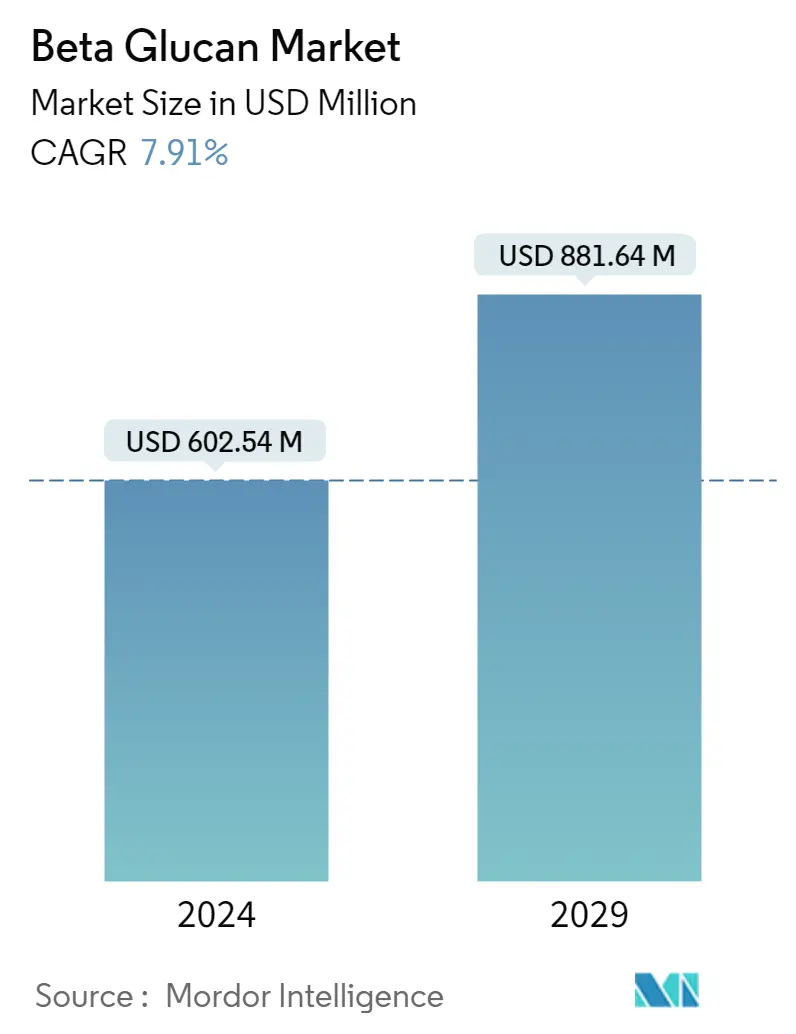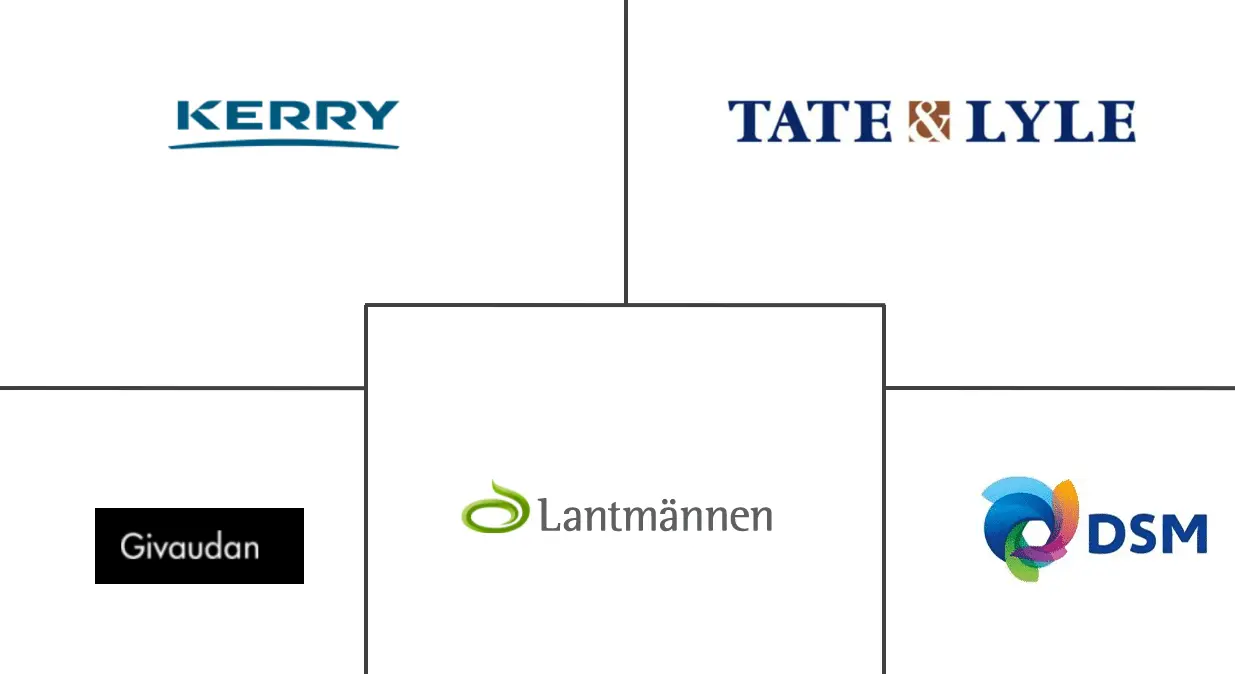Market Size of Beta Glucan Industry

| Study Period | 2019 - 2029 |
| Market Size (2024) | USD 602.54 Million |
| Market Size (2029) | USD 881.64 Million |
| CAGR (2024 - 2029) | 7.91 % |
| Fastest Growing Market | Asia Pacific |
| Largest Market | Europe |
Major Players
*Disclaimer: Major Players sorted in no particular order |
Beta Glucan Market Analysis
The Beta Glucan Market size is estimated at USD 602.54 million in 2024, and is expected to reach USD 881.64 million by 2029, growing at a CAGR of 7.91% during the forecast period (2024-2029).
COVID-19 pandemic is still transforming the growth of numerous industries, the outbreak's immediate impact is varied. While some sectors may experience a decline in demand, many others continue to stay unaffected and exhibit strong development prospects. The global beta-glucan market has been witnessing significant growth due to the increasing health and hygiene consciousness among consumers globally, owing to the impact of the COVID-19 pandemic. Consumers have grown more mindful of their health and proactive about maintaining it through healthy living. As a result, consumer demand has shifted from processed food to nutritious, low-calorie, non-oily, functional, and superfoods. Consumers have become more conscious of food ingredients and pay close attention to nutrition labels and product contents. This shift in consumer behavior has increased demand for healthy foods and supplements, prompting various producers to introduce new functional, non-genetically modified, and naturally produced food products.Furthermore, changing lifestyles, recovering economies, and shift toward natural products have been observed in developing economies, leading to the growth in demand for beta-glucan, not only in food & beverage, personal care, and pharmaceutical products but also in other industrial applications, including animal feed, cosmetics, and biofuel production.
Over the long term,Beta-glucans are biologically active fibers derived from the cell wall of various natural sources, including yeast, mushroom, oats, barley, and others, with the proven benefits for health and medical significance. The beta-glucans are allowed in several countries, including the United States, Canada, Finland, Sweden, China, Japan, and Korea, as potent immunological activators. Beta-glucans are not synthesized by the human bod. Hence, these are recognized by the immune system, and these induce both adaptive and innate immune responses.Currently, the available beta-glucan is sold for providing health benefits, such as the wellness of the cardiac system, immune system, digestive system, and others. For example, Leiber GmbH, a German manufacturer, offers a varied range of specialized yeast products, including Yestimun. Yestimun is an 85% pure beta-glucan derived from brewer's yeast. Beta-glucan is used for digestive health by triggering an immune-modulating response.Some of the players operating in the beta-glucan market are Tate & Lyle PLC, Kerry Group PLC, Koninklijke DSM NV, Super Beta-Glucan, Lantmännen, among others.
Beta Glucan Industry Segmentation
Beta-glucans are biologically active fibers derived from the cell wall of various natural sources, including yeast, mushroom, oats, barley, and others, with the proven benefits for health and medical significance. The beta-glucan market is segmented by category into soluble and insoluble and by application into food and beverage, healthcare and dietary supplements, and other applications. The food and beverage segment is further bifurcated into dairy, snacks, beverages, confectionery, baked goods, and other products, and the healthcare and dietary supplements into infant nutrition and other dietary and supplements. By source, the market is segmented into cereals, yeast, mushroom, and other sources. By geography, the market is segmented into North America, Europe, Asia-Pacific, South America, and the Middle East and Africa. For each segment, the market sizing and forecasting have been done in value terms of USD million.
Beta Glucan Market Size Summary
The beta-glucan market is experiencing robust growth, driven by increasing consumer awareness of health and hygiene, particularly in the wake of the COVID-19 pandemic. This heightened consciousness has led to a shift in consumer preferences towards nutritious and functional foods, which has in turn boosted the demand for beta-glucan across various sectors. Beta-glucans, derived from natural sources such as yeast, mushrooms, oats, and barley, are recognized for their health benefits, including immune system support and cardiovascular health. The market is witnessing a surge in product innovations and the introduction of new functional food products, as consumers become more discerning about food ingredients and nutrition labels. This trend is further supported by the growing popularity of natural and non-genetically modified products, particularly in developing economies, where there is a notable shift towards natural products in food and beverage, personal care, and pharmaceutical applications.
The market is characterized by the presence of key players such as Tate & Lyle, Kerry Group, and Koninklijke DSM, who are actively engaging in strategies like product innovation, mergers, and partnerships to strengthen their market position. The versatility of beta-glucan is evident in its applications across various industries, including food and beverage, nutraceuticals, pharmaceuticals, animal feed, and cosmetics. In the cosmetics industry, for instance, beta-glucan is gaining traction for its superior moisturizing properties compared to traditional agents. The food industry is also seeing increased incorporation of beta-glucan in products like baked goods and cereals, catering to the demand for easy-to-consume, health-enhancing foods. The ongoing research and development efforts, along with strategic collaborations, are expected to further propel the market's growth, as beta-glucan continues to be recognized for its potential health benefits and functional applications.
Beta Glucan Market Size - Table of Contents
-
1. MARKET DYNAMICS
-
1.1 Market Drivers
-
1.2 Market Restraints
-
1.3 Porters Five Force Analysis
-
1.3.1 Threat of New Entrants
-
1.3.2 Bargaining Power of Buyers
-
1.3.3 Bargaining Power of Suppliers
-
1.3.4 Threat of Substitute Products
-
1.3.5 Intensity of Competitive Rivalry
-
-
-
2. MARKET SEGMENTATION
-
2.1 By Category
-
2.1.1 Soluble
-
2.1.2 Insoluble
-
-
2.2 By Application
-
2.2.1 Food and Beverage
-
2.2.1.1 Dairy
-
2.2.1.2 Snacks
-
2.2.1.3 Beverages
-
2.2.1.4 Confectionery
-
2.2.1.5 Baked Goods
-
2.2.1.6 Other Food and Beverages
-
-
2.2.2 Healthcare and Dietary Supplements
-
2.2.2.1 Infant Nutrition
-
2.2.2.2 Dietary Supplements
-
-
2.2.3 Other Applications
-
-
2.3 By Source
-
2.3.1 Fungi
-
2.3.1.1 Yeast
-
2.3.1.2 Mushroom
-
-
2.3.2 Cereals
-
2.3.3 Other Sources
-
-
2.4 Geography
-
2.4.1 North America
-
2.4.1.1 United States
-
2.4.1.2 Canada
-
2.4.1.3 Mexico
-
2.4.1.4 Rest of North America
-
-
2.4.2 Europe
-
2.4.2.1 Germany
-
2.4.2.2 United Kingdom
-
2.4.2.3 Italy
-
2.4.2.4 Spain
-
2.4.2.5 Russia
-
2.4.2.6 Rest of Europe
-
-
2.4.3 Asia-Pacific
-
2.4.3.1 China
-
2.4.3.2 Japan
-
2.4.3.3 India
-
2.4.3.4 Australia
-
2.4.3.5 Rest of Asia Pacific
-
-
2.4.4 South America
-
2.4.4.1 Brazil
-
2.4.4.2 Argentina
-
2.4.4.3 Rest of South America
-
-
2.4.5 Middle East & Africa
-
2.4.5.1 South Africa
-
2.4.5.2 Saudi Arabia
-
2.4.5.3 Rest of Middle East & Africa
-
-
-
Beta Glucan Market Size FAQs
How big is the Beta Glucan Market?
The Beta Glucan Market size is expected to reach USD 602.54 million in 2024 and grow at a CAGR of 7.91% to reach USD 881.64 million by 2029.
What is the current Beta Glucan Market size?
In 2024, the Beta Glucan Market size is expected to reach USD 602.54 million.

